Search results
56 results found.
56 results found.
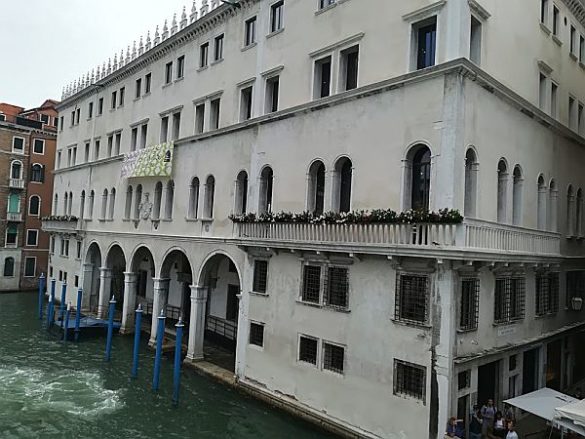
I’ve always had an aversion to the word “lifestyle,” not because I don’t believe that lives can have style, but because I do believe that it isn’t something you can buy. Somebody will say “Oh but you can buy the components,” so fine — but you can’t buy the result. There is a difference between style and stuff.
What brought this on? Assorted publicity distributed around the city for the Fondaco dei Tedeschi, which once was a palace, then became a fontego, which was a designated place in which the Venetian government required foreign merchants to deposit their goods, and which also could comprise bedrooms, counting and meeting rooms, and other conveniences. (The Turkish fontego contained a mosque and a hammam.) At some point in the 20th century it became the main post office.
I remember that phase — the palace seemed impressively maladapted to being a main post office, with lots of small rooms and way too many stairs. But I liked it. I liked going into a majestic, dusty, rumpsprung palace to buy stamps or deal with packages. The fontego seemed still connected in some way to its past. It was a piece of Venice.
Then it was closed for several years while undergoing vast and spectacular alterations under the world-famous hand of rockstar architect Rem Koolhaas on behalf of the Benetton Group. This project transformed the building into a — well, I would have called it a shopping center, somebody else might have called it a souk, but they decided to call it “A lifestyle department store.”
Department store — how quaint. I didn’t know people still used that term. But Venice already had one: COIN, the immemorial high-class department store that was forced to close last month because the building owner raised the annual rent to just beyond reach. The owner wanted 3,000,000 euros a year, while the longstanding lessee could only offer 2,100,000. So for 900,000 euros difference per year, the store has closed.
Now that I think about it, COIN was just over the bridge from the Fondaco. I don’t suppose that means anything.
Anyway, maybe you’re thinking: “This is great! Finally there will be high-class stores in Venice where we can go to shop! Because Prada and Gucci and Tiffany don’t have their own stores right out there on the street!” (Of course they do. It’s just that they’re not all jammed together and linked by escalators.)

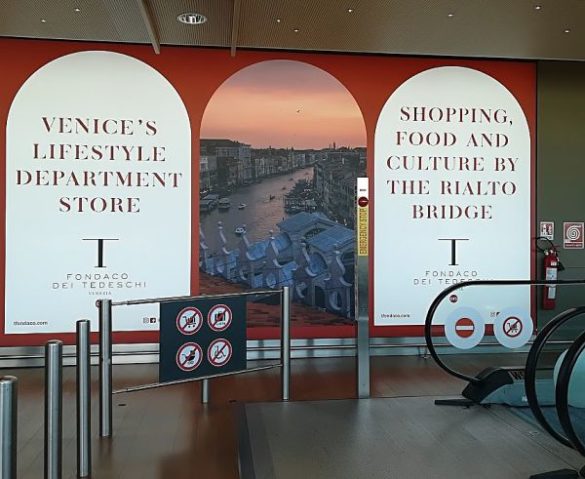
Posters for the Fondaco have been on the vaporetto docks for a few weeks now, and I recently discovered even fancier publicity for it in the airport. This makes sense, because the fondaco is totally geared to tourists. I seem to recall reading, during the renovation phase, that specific tours were going to be organized to visit it, like Mall of America. Water taxis would bring customers in big batches to the water entrance, let the customers roam and spend and take pictures, then take them away again.
Whether or not that particular scheme has worked out, there are indeed many, many people who go there every day to roam and spend and take pictures. Or take pictures, anyway. And that ought to be making the owner/manager happy. But he wants more.
He wants Venetians.
Headline in the Gazzettino: “Fontego has 8,000 visitors a day, but ‘We wish Venetians would come to shop.'” Why? Aren’t 8,000 people a day enough? Any Venetian reading this would hear “Please come to our extremely upscale multilevel shopping mall full of thousands of strangers to look at useless things that cost too much.”
I don’t suppose you’d call a cashmere sweater useless, but your average Venetian who needs a really good sweater doesn’t think of going somewhere that has 8,000 visitors a day when he or she can just as easily go to the Duca d’Aosta and also have air to breathe. If he or she wanted to see 8,000 foreigners crammed together, wandering aimlessly, taking pictures, he or she could just as easily go to the Piazza San Marco, which doesn’t cost anything.
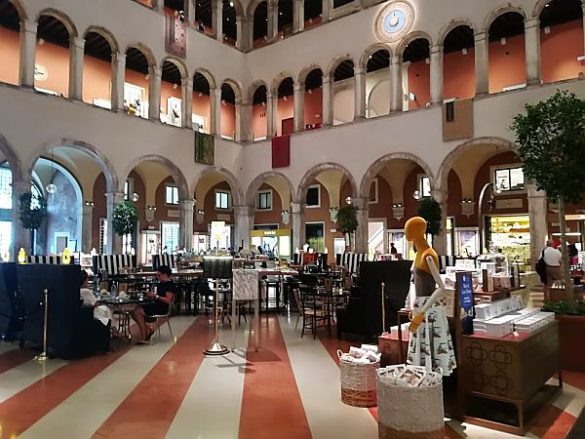
A small further point, which has not occurred to the “We want Venetians” gentleman, is: Who are these Venetians? As in happening in a number of Italian cities, Venice’s population is aging, and living on a pension is a situation that doesn’t leave much room for frippery. Certainly there are some people with pensions paid in gold doubloons, but the largest percentage of the retired people here are living on 1,000 euros or so a month; Lino’s cousin has 750 euros a month, and many others are somehow surviving on 500 euros a month. You can understand that Murano glass and Carnival masks and custom-concocted perfumes are nowhere to be found on their shopping lists.
So the Venetian visitors that are so earnestly desired and dreamed of can’t be pensioners. They probably aren’t working couples, either, because work. Children, maybe? Well, they’d have to come with some adult — could be a grandparent or aunt or uncle — but the adult would need to have money, so we’re back to pensioners.

There is another element to the general Venetian aversion to stopping by the Fondaco, and it’s not financial. It’s cultural and emotional. Does the word “dispossessed” mean something? It means “It was ours, and now it’s not,” and this now applies to many historic places that have been transformed (often by Benetton, but not always) under the pretext of being saved from ruin when they are essentially large commercial speculations. I suspect that the person who said that he wishes Venetians would come to shop secretly knows that Venetians are never going to do it, and he knows why. Because it was theirs, and now it’s not.

Is tourism to blame? I suppose so. But as long as non-Venetians keep ranting about the dire effects on local life of renting apartments to tourists, the reality of foreign commercial interventions on a massive scale goes unremarked. Big opening-day articles analyzing the architectural skill of the Fondaco transformation sidestepped the fundamental reality that another exceptional piece of Venetian history had been surgically removed from the city’s battered body.
As anyone can say who has been in, or witnessed, an abusive relationship, there are some similarities between the Venetian government and its relationship with the city’s history and its present, not to mention future, if there is one. But the primary point that strikes me (sorry) is that an abused person tends, always hopefully, to see each episode of damage as somehow excusable, and this only leads to more, and finally the victim loses the big picture and sinks into apathy, helplessness and depression. It seems to me that many Venetians have reached this point.
So I would suggest to the owner/manager not to press the point of how tempting and wondrous the Fondaco is. Believe me: If Venetians had wanted to, they already would have come. You’re going to have to be satisfied just harvesting tourists who are seeking a lifestyle.


Two wonderful young women who have rowed with us over the past three years (when their studies would permit) graduated from Ca’ Foscari, the University of Venice, last Friday: The middle of the Piazza San Marco was awash in diplomas, theirs along with 1,122 other exuberant “doctors” of whatever their subject was.
This was the 20th year that a mass graduation ceremony has been held here for students from Venice and Treviso. The typical procedure, as we have seen in the case of some other friends, is that the candidate confronts a panel of professors and is interrogated on the subject of their thesis, nerve-wracking for the candidate and just wracking for the friends and family sitting behind him/her because there are no microphones. It’s like watching a closed-circuit television with the sound off, except you’re right there.
But for whatever administrative reason there may be, the November group was rounded up and given the graduation ceremony all’ americana, complete with mortarboards crowning their heads (though some received their more traditional laurel wreath afterwards). Clearly one reason why it was held in the piazza was because there isn’t anywhere else, except maybe the soccer stadium, that would hold three thousand people.
Anyone getting their degree is said to have received their laurea (LAOW-rey-ah). Or, as Toto’, the immortal Neapolitan comic, earnestly termed it in a film, their laura (LOW-ra), which cracks me up because that’s just Laura.
Apart from the amazing setting, the experience was Classic Graduation: There was confusion, emotion, and the boilerplate commencement address(es) focusing on their future and the need to continue to nurture their dreams and not to ever let the world beat them down. “Yours is not a point of arrival, but of departure,” said Paola Mar, councilor for Tourism representing the city administration. “Be passionately curious and ask yourselves every day the ‘why’ of things. Curiosity can guide you into new paths.” There was praise for their perseverance and their talents and collective hopes for whatever comes next in their lives. I have no idea how a graduation can be considered official without the majestic soundtrack of “Pomp and Circumstance,” or at least the Triumphal March from Aida, but graduate they did.
I have no pictures of our friends together because I never saw them, being on the outside of the sacred enclosure where parents and close relatives were huddled, shivering as the sun slid behind the Ala Napoleonica. Everyone was listening to the names as they were called — the list was so long that the university divided it into half at the letter “M,” and called out the names in pairs. Happily for me, Marta and Camilla’s last names begin with “C” and “D,” so I went home (by now I was shivering too) as soon as I heard them called. I missed seeing the jubilant thousand fling their mortarboards into the air, so no photo of the peak moment. I’m happy enough just to be warm and imagine it.

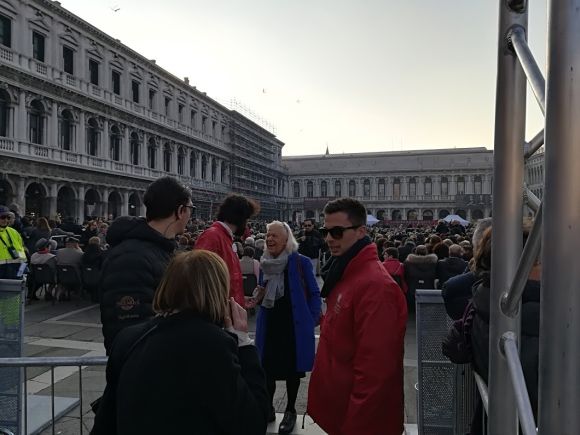

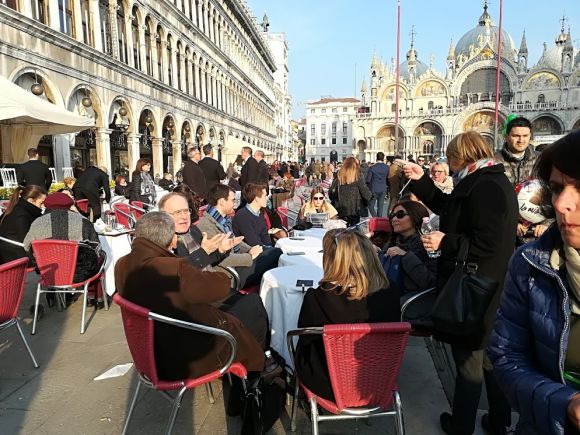

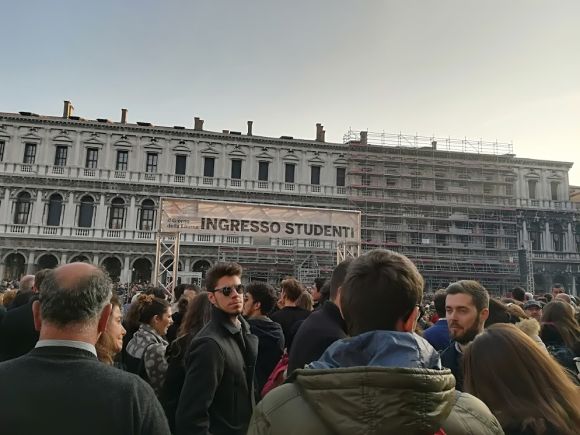
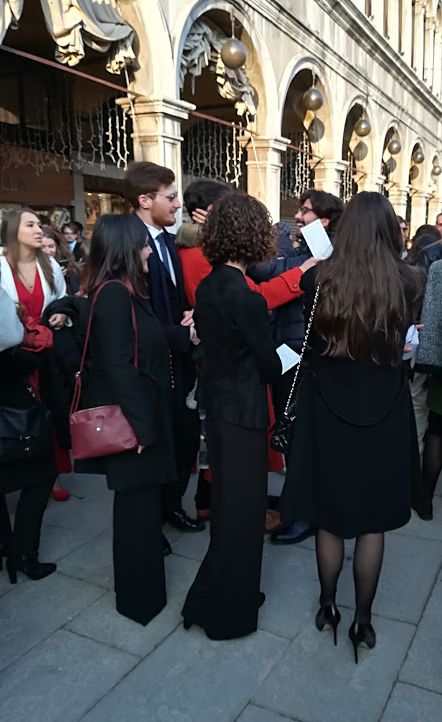


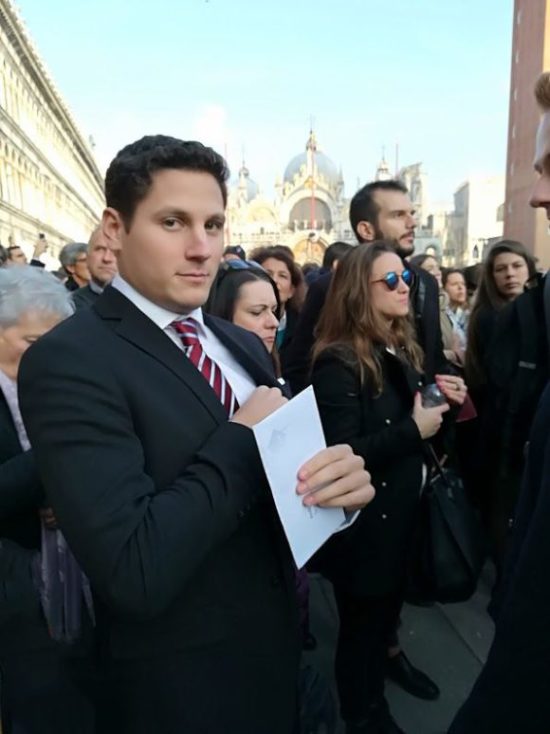

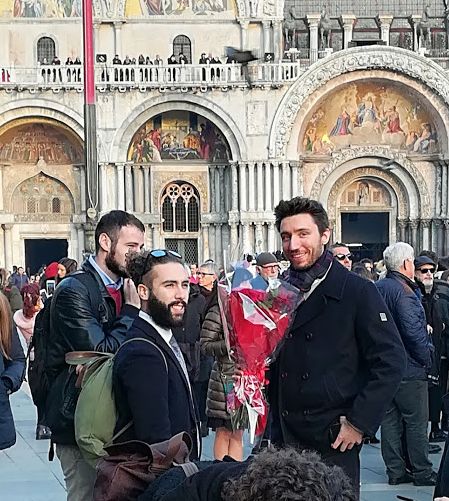



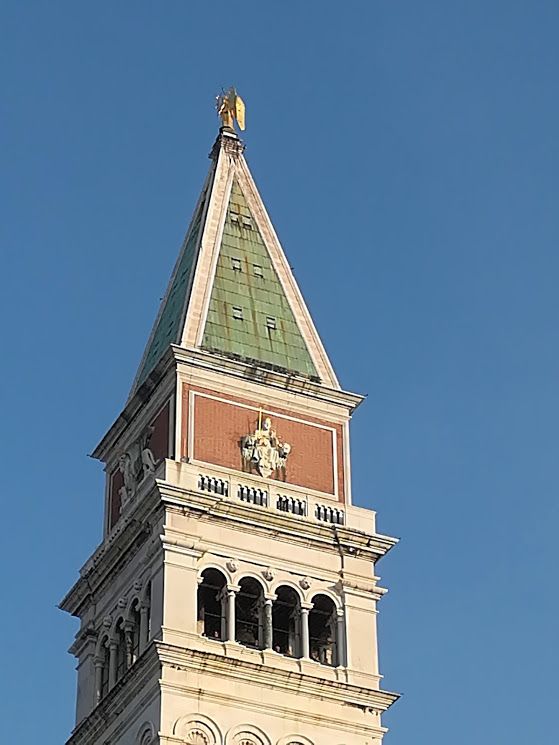
A few times each year, the subject of motondoso leaps into the headlines. I wrote about some of this phenomenon a good while ago. While I wait for more pressing news to emerge, I will add this post to the general fund of knowledge. Don’t be looking for a happy ending.
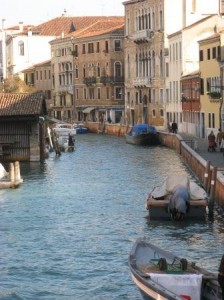
The area available for waves to dissipate. This is a crucial factor because all these hydrodynamic formulas wouldn’t have to matter except for those pesky canals, whose walls trap the waves.
The waves travel till they hit a wall, then bounce back, then hit the other wall, and this continues till they wear themselves out and disappear. Depending on how much traffic passes in the canal in question, they might disappear sometime around midnight. Typically, enough boats a day (and it doesn’t have to be thousands) pass through so many canals making so many waves that they don’t have time to dissipate, so they just keep going, banging back and forth into each other and into each side of the canal, each time giving just another little hammer-blow to whatever building they reach. That probably didn’t need to be explained. The depth of the water also influences the waves in certain ways, but of course the depth varies according to the tide, so let’s move on.
Building foundations. This is obvious. Some Venetians have told me that they believe nothing will be done to resolve this situation till an entire building collapses. Stay tuned.
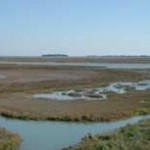
People. Waves are a hazard to ordinary people in several ways. The most obvious is the risk of capsizing. Even on land, you can’t be sure you’re safe. The insidious subterranean erosion caused by the waves continually sucking soil out from under pavements means that sometimes a person suddenly falls into a hole. It happened to a woman walking along near the Giardini one day — she put her foot on a stone, it collapsed, she fell into a hole higher than she was. Nobody in the neighborhood was surprised; they’d been sending complaints to the city to no avail. Then there was the child playing on a stretch of greensward at Sacca Fisola facing the Giudecca Canal who suddenly fell into an unsuspected weak spot in the ground. If a man with quick reflexes hadn’t grabbed him, the child would have long since gone out to sea.
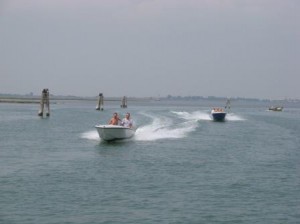
The Venetians have a saying: “Water has no bones.” This means that water can go anywhere it wants to. They should know — Venice has a long history of brilliant hydraulic engineering, up to and including cutting the river Po to re-route it southward, thus preventing the eventual silting-up of the lagoon. If they hadn’t done this in 1604, Venice would have long since been surrounded by cornfields. Or more probably by the world’s biggest parking lot. This knowledge and sense of self-preservation now exists only in a vastly sub-divided and disconnected form which only serves one tiny, specific purpose, usually unrelated to any larger context.

Who’s responsible?
Division of jurisdiction. The term “battle against motondoso” is now a cliche. But exactly who is conducting this battle? By now there is “an exuberance,” as the Italians might put it, of agencies and organizations involved in some way in managing the lagoon. The Magistrato alle Acque was established in 1501 to resolve administrative conflicts and simplify redundancies. Now it’s just one more in the herd. The lagoon is divided into areas overseen by agencies representing a large array of sometimes incompatible interests, charged with enforcing laws which sometimes contradict each other. The waters lapping at Venice’s feet are subdivided according to their primary use: shipping channels, small internal canals, approaches, which are variously overseen by the Capitaneria di Porto, the Magistrato alle Acque, the city of Venice and/or the province of Venice. Parts of the lagoon have been designated as Special Protection Areas (SPA) under the European Habitats Directive, but they exclude the central part of the lagoon, the major shipping lanes, and the shoreline Industrial Area — just the places where motondoso is most likely to be found.
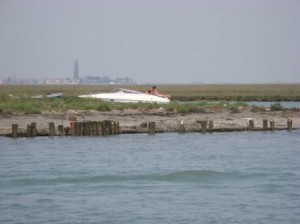
Everybody with a boat. Over time, the voices blaming everyone else blend like an entire city singing “Three Blind Mice.” (I would say “Row, row, row your boat,” but that would be silly.) The vaporetto drivers say it’s the barges. The barge drivers say it’s the taxis. The taxi drivers say it’s the private boats. The private boats say it’s everybody but them. And so it goes. I’m not sure what the legal value is of a defense strategy formed around “I did it, but he did it worse.” But whoever is in a motorboat for work reasons considers himself to have a free pass. And whoever is in a motorboat for fun automatically counts himself out because he’s not there every day, so how could he count as a culprit?
Studies by the Venice Project Center have revealed that the highest wakes are produced by the small barges (“topo-motore“). Next were the taxis. Vaporettos produced the least, but that doesn’t let them off the hook entirely, for two reasons. One, “least” doesn’t mean they produce no wake, so I don’t regard “least” as any kind of gold star. Second, instead of bigger waves they produce something which none of the other motorboats do, which is a powerful whirlpool.
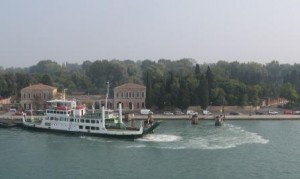
Every time a vaporetto ties up to the dock to let passengers on and off, the motor stays in full-steam-ahead mode. The reason given is that it makes the boat more secure for the passengers in transit. I won’t contest that here, but will say that the vortex creates a kind of suction effect (think of rinsing out your mouth) which is also damaging to the nearby foundations.
What to do? Stricter enforcement of speed limits. It’s the most obvious solution, even to Venetians. Generally speaking, the limit in the small inner canals is 5 km/h, in the Grand Canal and some larger canals it’s 7 km/h, and in some others (such as the Canale di Tessera leading to the airport) it’s 11 km/h. But, as noted earlier, these are just numbers on a page. Many and varied have been the proposals, most of which have some merit but which frequently suffer from the fatal flaw of being unenforceable. Shortage of personnel, inter-bureau jealousies, and lack of consistency and simple lack of will on the part of everyone has shown this solution to be impossible. I don’t mean literally impossible, I just mean impossible here. Require hulls and horsepower to be changed to the minimum-wave-producing conformation. Nobody wants to pay to get a new boat with a less wave-inducing hull, though it occurs to me that now would be a brilliant moment to launch a “Cash for Clunkers” program for commercial boats. If cost is the only thing holding people back (it isn’t) this would be an intelligent place to start. If it’s not cost, what is it? Civic pride isn’t even mentioned as an incentive.
It’s Sloth. “We’ve always done it this way.” “It’s too much trouble.” “Why me?” How to overcome that? You can’t. It’s as difficult to convince workers-with-boats as it is poachers that they are gradually killing their source of livelihood. You can only create a new situation and then enforce it till it becomes habit. I have several solutions in mind, each of which would have an appreciable, even dramatic, effect on motondoso. The costs involved are all to be considered as investments in the future not only of the person using the boat, but of the city itself.

If I were in charge, I would add the following to all of the above:
I would also stipulate a limit on the horsepower of each category, including pleasure boats. Since people can’t retain the concept of slowing down on their own, I suggest requiring their equipment do it for them. As for those who might protest, I would have a one-size-fits-all response: Do it or seek employment elsewhere. The world must be full of people who would be happy to work for even one quarter of what your average taxi driver (I refer to the legal ones, not the fleet of illegal ones) makes in a year. Or even what they make in a month. If this notion for some reason is deemed unfeasible (I can’t see why), I would suggest immediately hiring a large quantity of extra police solely to enforce speed limits, imposing fines so steep that a quick calculation on the back of an envelope would show that it made more sense to buy a new, non-wave-making boat right now than pay two fines. The vital element here is that a person has to be at least 99 percent convinced that he will be caught and fined, a certainty which can’t exist today when the forces of public order have been reduced to skeleton crews who mainly race around solving emergencies.
The councilor for Tourism and Decorum, Augusto Salvadori, made a proposal some while back (I think he even may have made it twice): Engage squads of volunteers from the ranks of the rowing clubs, whose job would be to row around and blow whistles at whatever transgressors they encounter. This might possibly work (I’m being generous here) if there were enough people, if there were immediate and drastic follow-up, and if the transgressors weren’t inclined to run you over. My sense is that none of these conditions apply. Well, there’s prayer. They’ve tried that too. A few years ago there was a big initiative to amass members of all of the rowing clubs at the church of the Madonna della Salute (Our Lady of Health) on November 21, her feast-day. Considering that she saved Venice in 1630 from the catastrophic plague which was destroying the city, there was some poetic power in the notion of everyone going to her church and offering a candle in supplication for salvation from this latest plague. Grand symbolic gestures are so much fun; they make everybody feel so good. Reminds you of why Italian opera is so impressive. Then it’s over, and everybody goes home. And tomorrow begins just like it did yesterday, and nothing has changed.
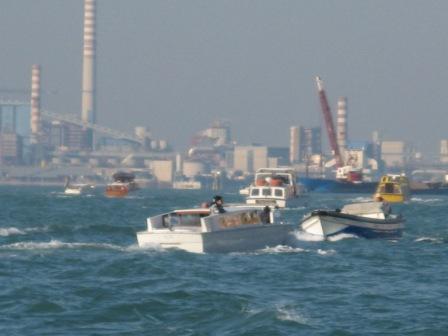

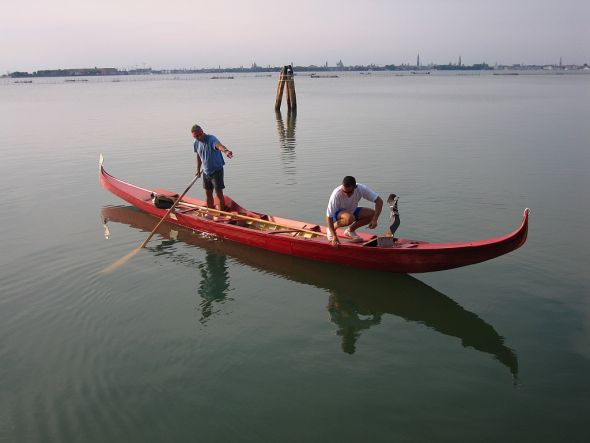
Just when I had concluded that there was nothing different or interesting to say about Venice, just when I thought life here was going to continue to grind deeper and deeper into its rut (same old problems, same old remarks, same old endless cycle of birth and rebirth), comes a blast of rage from person or persons yet to be identified.
Whoever they were, they trashed 7 of the gondolinos belonging to the city, discovered just today on the last day of the gondolino eliminations for the Regata Storica. The “Storica,” as you know, is the ultimate race, and it is conducted aboard the gondolinos. There is a total of 9, plus the reserve boat. Three boats, which were in another place and therefore escaped the axe murderer(s), weren’t much to work with for the eliminations today, but the nine two-man crews were divided into three sets of three, and extra time was eaten up with the removing and re-installing of the forcolas of each rower at each change. The mayor has tweeted that the boats will be repaired in time for the race on Sept. 4. Five boatyards have thrown themselves into the work.


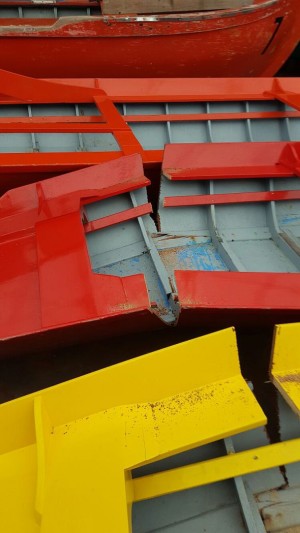

Who would do such a thing? Plenty of police are working to find out. But who would WANT to do it? Who indeed? It might be disaffected office-seekers, or environmentalists protesting deforestation, or people who want Jodie Foster to fall in love with them, or anything.
There has been tension in the rowing world recently, it’s true. But until all the dust has settled, and been left there as long as I usually leave it anywhere, and then finally Pledged away, I’m not going to start theorizing.
I can mention, however, that a sense of anarchy stretching beyond the world of rowing seems to be threatening what ought to be well-earned somnolence in the city. Tourists keep trying to swim in the Grand Canal. A New Zealander, one of the crew of a yacht in port, got drunk a few nights ago, jumped off the Rialto Bridge, and landed right on the windshield of a water taxi passing below. The mariner is in the hospital in very bad condition, and the taxi is also in the shop.
Here is a recent video from Roberta Chiarotto, on her Facebook page https://www.facebook.com/roberta.chiarotto/videos/10209231322756467/
We see some young people in their bathing suits in Campo San Vio, heading for a refreshing dip. The voice of the Venetian woman reprimanding them, in English and German, basically says “This isn’t Disneyland, it’s a city. You can’t do this.” For those (like Lino) who remember swimming in the canals as little tykes — naked, learning to swim tied to their mother’s washboard — may I say that there was less dangerous traffic then, and by the way, they were merely little tykes. Healthy full-grown hominids who are not in their own back yards should be aware, if only dimly, of the appropriateness of some behavior. If in doubt, I’d suggest “Don’t.”
What amazes me is how tranquilly these visitors receive this unwelcome news, and how unconvinced they look. And they’re not an isolated case; a few weeks ago, five young French tourists took the plunge in the Grand Canal in front of City Hall, no less. I won’t continue this list, because however many times I might mention it, I still can’t believe it. And it seems to have no effect.
Once again driven to distraction, some exasperated resident recently snapped, posting a sign near Campo San Martin:

On a more serious but equally anarchic note, two nights ago there was a nearly fatal collision in the lagoon (that’s good news, considering that at least once a summer there is a completely fatal collision to report). A motorboat being driven at high speed — that’s redundant, pretty much all motorboats are driven at high speed in the lagoon — ran right straight into a passing water taxi. The motorboat sank, the ambulance came, the two young men are in the hospital and the girl escaped unharmed. The high-spirited young folks had been zooming along with no lights on their boat, lights which are not only required by law but which common sense reveals would have at least given the taxi driver some hint as to their imminent arrival.
My point is that a great deal of anarchy can be tolerated, for many reasons, as long as nothing happens, which is what everybody is counting on. And then something happens. Like ramming a taxi.
Consequences can be so unpleasant. And they follow deeds with such annoying persistence.